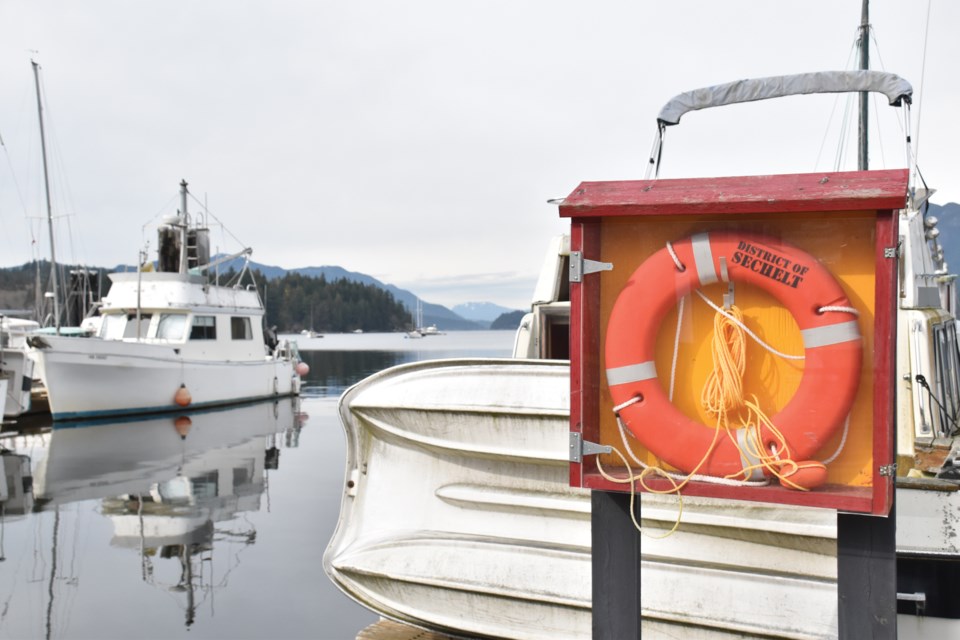Transport Canada is expected to conduct a “sweep” of mooring buoys, floats and vessels in Porpoise Bay once public health guidelines around non-essential travel ease as part of its Navigation Protection Program (NPP) enforcement work.
The compliance monitoring is expected to cover the portion of Porpoise Bay south of Poise Island, according to Transport Canada, which told Coast Reporter its officers will “go where they see there are vessels and buoys.”
Any removal of buoys and vessels would be prioritized “according to the degree of obstruction to navigation and the potential hazard they present to public safety.”
According to West Vancouver-Sunshine Coast -Sea-to-Sky Country MP Patrick Weiler, the sweep is “something that’s been prioritized as part of [Transport Canada’s] compliance work this year,” though he could not provide a precise timeline since it’s dependent on when travel guidelines ease.
The work will involve assessing whether buoys, floats and boats comply with Transport Canada regulations according to the Wrecked, Abandoned or Hazardous Vessels Act.
In the case of unauthorized vessels, NPP officers would notify the owner, and if they can’t be reached, officers may take the vessel to a third-party storage facility where, if an owner doesn’t come forward, it would be classified as abandoned and disposed of under the Act.
Local governments, including shíshálh Nation and the District of Sechelt, residents and community groups have communicated their concerns about unauthorized vessels, buoys and floats, said Weiler, when asked why the sweep was needed.
“If there are illegal moorages that are taking place there, those need to be rectified,” he said.
In 2016, the District of Sechelt’s bylaw enforcement officer reported 29 derelict vessels were submerged or floating within 300 metres from shore in Porpoise Bay.
Sechelt Coun. Eric Scott, who sits on the harbour expansion and development select committee, said according to public works that number presently fluctuates between 25 and 30.
He has been actively lobbying for the federal government to take action as the committee tries to establish a harbour authority in the area – a priority that led council to strike the committee in the first place.
“We have a number of people living out there that basically aren’t abiding by the laws and we have no control over the damage that they’re doing to the ecosystem,” said Scott, citing human waste and debris flowing directly into the bay and illegal buoys secured in eelgrass beds. “The harbour is dying, to put it bluntly.”
While Transport Canada regulates sewage discharge into water from vessels, its enforcement is complaint-driven and it was not able to provide Coast Reporter with data.
Resident Angelia Darnbrough, who has been lobbying all levels of government since the arrival of the notorious Gulf Stream in Porpoise Bay waters four years ago, said the sweep is a step in the right direction, but ultimately she wants to see a harbourmaster hired to oversee the area.
She provided water quality results to Coast Reporter from two days of testing at Reef Road and processed through Vancouver Coastal Health in 2016. They showed 450 and 550 E. Coli per 100 millilitres – which exceeds the health authority’s threshold for safe amounts for swimming.
The removal of boats and enforcement is “a jurisdictional mess,” said Darnbrough. “Nobody wants to own the problem.”
Both she and Scott attended a Feb. 9 meeting where Weiler identified the sweep as a priority.
In a follow-up letter, Weiler noted the need to advocate for a harbour authority as a “long-term enforcement solution,” and that he had reached out to the Department of Fisheries and Oceans (DFO) about the process.
As a short-term solution, Weiler supported clarifying jurisdictions and posting those boundaries on the government wharf, as well as a number to call to report concerns.
Establishing a harbour authority is particularly difficult because of the cost and the number of governments and departments with a claim to the area, including District of Sechelt, shíshálh Nation, Sunshine Coast Regional District, the province and both DFO and Transport Canada.
Currently the District of Sechelt manages the wharf under contract with DFO’s Small Craft Harbours Program.
Scott said DFO is looking to divest the wharf and has offered shíshálh Nation first right of refusal. Coast Reporter asked for confirmation from Chief Warren Paull but did not receive a response by deadline.
As for people living on the water, Weiler said the issue of evicting people in precarious housing situations “can’t be ignored.”
“While it’s important that people follow the law and are not engaged in activities that are illegal or could otherwise harm the bay, we need to make sure that we’re not going to put people in a situation that’s even worse,” he said.
Transport Canada said if a vessel is determined unsafe to occupy, the owner would have to work with “appropriate agencies” to secure housing, if needed.
“When a vessel or buoy obstructs navigation, Transport Canada can order the vessel or buoy to be relocated or removed. If the owner fails to comply then Transport Canada would be in a position to have it removed.”
At least two people linked to vessels in the bay have died over the past four years.
Recently Transport Canada has been involved in the removal of the R.B. Green, which was assessed for removal under the Abandoned Vessels Act after the tugboat sank in April 2017. The owner passed away later that year.
In February, the body of Peter Koch, a 63-year-old man living in a vessel at anchor near the Government Wharf, was retrieved from the water after his dinghy capsized.
The incident triggered Royal Canadian Marine-Search and Rescue Station 12 crew to fundraise to purchase PDFs and lifejackets for people in the bay.



